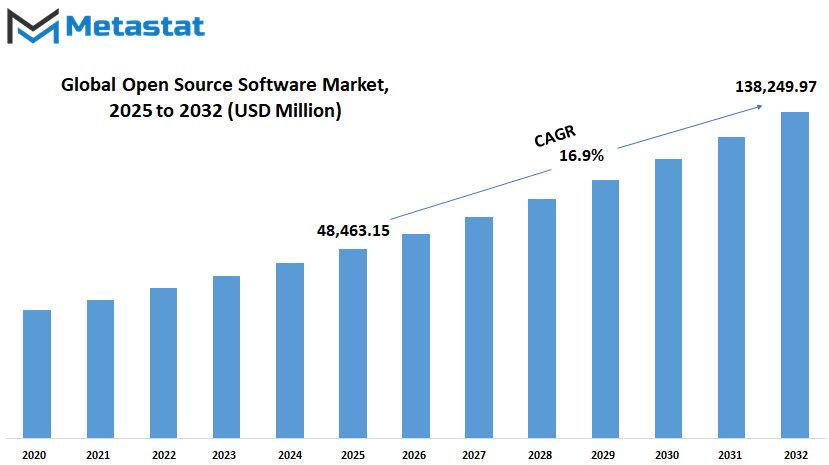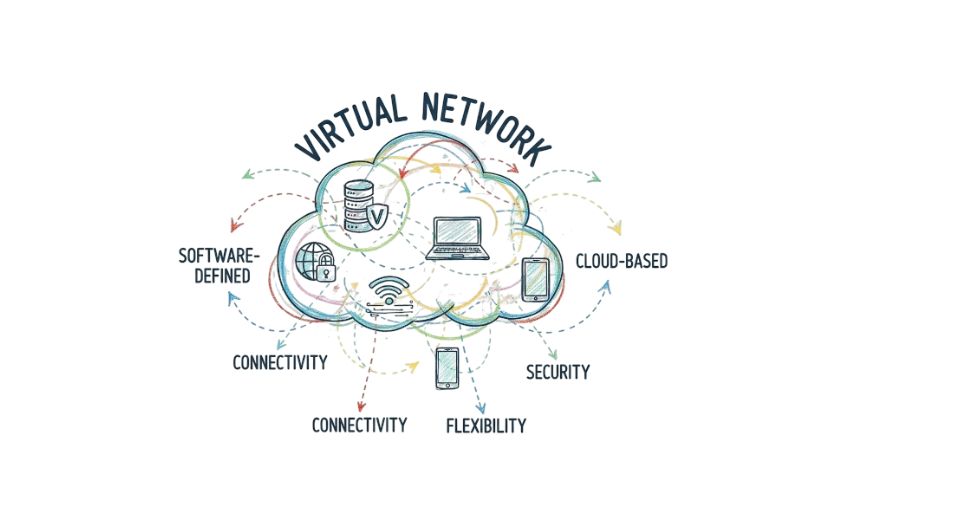MARKET OVERVIEW
The Global Open Source Software market and industry have greatly been a dynamic sector that is changing the very face of technology and business systems around the world. This market refers to the software solutions designed with open-source codes that allow developers and organizations to modify, distribute, and enhance applications free from traditional licensing restrictions. The market for open-source software will grow in the future, based on the ever-increasing demands of flexibility, cost-effectiveness, and cooperation, and affect innovation across various industries.
The industry covers areas such as IT, healthcare, finance, education, and telecommunications, offering custom solutions to cater to different needs in operations. Software types under this market include operating systems and databases, enterprise applications, and cybersecurity tools. Open-source software is different from proprietary software as it promotes openness, security, and community-led innovation, hence making it the best choice for companies seeking flexible and scalable technologies.
As enterprise companies embark on the journey of embracing digital transformation strategies, the open-source software will remain relevant. Organizations require these solutions for automation, cloud computing, artificial intelligence, and data analytics, streamlined processes, and increased operational efficiency. The freedom of software customization provided to businesses based on their explicit needs gives companies a chance to experience a competitive advantage by avoiding dependence on usual vendors and reduced technology expenses in general.
The future of this market will be defined by global cooperation, where developers, contributors, and enterprises around the world will work together on advancing software in order to constantly improve and update it. The cooperative environment, in turn, fosters innovation in the development of advanced software solutions that embrace emerging technological trends. Organizations utilizing these tools will be able to be more agile, thus being better positioned in an increasingly digital environment.
With growing cybersecurity concerns, businesses are expected to invest more in open-source security solutions. These tools offer enhanced visibility into code vulnerabilities, enabling proactive threat detection and mitigation. Enterprises will continue to explore hybrid models, integrating open-source components with proprietary software to optimize performance and security. The interoperability of open-source software with existing IT infrastructure makes it a practical choice for organizations transitioning toward modernized systems.
Geographically, the market witnesses considerable participation from North America, Europe, and Asia-Pacific. Open-source technologies gradually gain acceptance in developing economies. The governments and enterprises in these regions realize the benefits of vendor independence and community-driven development and so encourage mass adoption. As regulatory frameworks continue to evolve, policies propitious towards open-source initiatives will push the market further ahead.
The Industry will benefit more from the role of cloud computing as organizations become more concerned with shifting towards cloud-native applications. Open-source platforms are going to continue to influence the clouds, providing scale solutions suitable for businesses no matter the scale. Enterprises who seek agility and seamless integration, currently on the rise, will be implementing those technologies and will further strengthen the market’s relevance in a fast-moving digital landscape.
The Global Open Source Software market would undergo changes as new technologies would be integrated and developed together. Business users and developers alike would look into alternative possibilities and would therefore force the scope of what’s feasible with this software. Future IT infrastructure, more than ever, would rely on the open-source route, working its way towards greater openness, reduced costs, and technological advancement.
Global Open Source Software market is estimated to reach $138,249.97 Million by 2032; growing at a CAGR of 16.9% from 2025 to 2032.

GROWTH FACTORS
The global open source software market is expected to grow exponentially in the coming years with several driving factors. One major reason why it will expand is due to cost-effectiveness and flexibility over proprietary software. A lot of businesses and organizations are looking to cut down costs without sacrificing performance, and an open-source alternative comes out as an attractive option.
Unlike licensed software, which often comes with high upfront costs and recurring fees, open-source software is freely available, allowing companies to allocate their budgets to other critical areas. Additionally, the ability to modify and customize these solutions makes them highly adaptable to various business needs, leading to wider adoption across industries. Its application in cloud computing, artificial intelligence, and enterprise IT solutions has been the main driver for its growth in the market.
Cloud platforms have emerged as the mainstay of the modern digital infrastructure, and open-source tools have a great role to play in their development and management. The trend towards applications based on AI is raising the demand for scalable, efficient, and cost-friendly solutions. The open-source frameworks and tools are at the forefront of most AI and machine learning innovations; hence, a business would always want to lead in this fast-paced digital marketplace.
Similarly, enterprise IT systems are embracing the use of open-source technologies as a way to increase efficiency while streamlining processes, thus continuing to push up the demand for these solutions. However, even with such growth drivers, some challenges might cause the market's expansion to decelerate. Security vulnerabilities are one of the most significant concerns since open-source software is accessible to anyone, even cyber attackers who may exploit the weaknesses.
While proprietary software has dedicated support and regular security updates, open-source solutions rely on community contributions that sometimes result in inconsistent patching. Compatibility issues with proprietary systems also make things difficult for businesses that require seamless integration between different software environments. Many organizations also face compliance challenges as regulatory requirements do not always align with the open-source development model, which complicates its adoption.
However, the future seems bright for the Global Open Source Software market. Blockchain, cybersecurity, and the Internet of Things are increasingly adopting open-source solutions. It allows blockchain technology to be used through open-source contribution, enabling innovative financial services and supply chain management, among many other areas.
Cybersecurity solutions in open-source frameworks allow the enhancement of these by collaboration in developing defense mechanisms to combat threats constantly evolving in this field. On the other hand, IoT technology requires adaptive, scalable software solutions, so companies and developers like to build software on an open-source platform. As these technologies will move forward, open-source solutions will have a greater level of influence on the digital future.
MARKET SEGMENTATION
By Type
The Global Open Source Software market is expected to experience tremendous growth in the coming years as more businesses and individuals adopt free and open-source solutions. This market includes different types of software, including operating systems like Linux, development tools such as IDEs and frameworks, database management software, cloud computing solutions, and security software. As organizations look for cost-effective, flexible, and community-driven alternatives to proprietary software, the demand for these technologies is expected to increase.
Among the key factors contributing to this transformation is digitalization. The firms are migrating toward cloud-based infrastructure, and the open-source system is something which they can leverage to grow. Cloud computing software has emerged significantly because it will help organizations in reducing their operating costs and ensuring that their data is within control. Open source technologies are a part of their services that some of the top cloud providers integrate, thereby fuelling market growth.
The second sector in which open-source software makes a big impact is security. Organizations today demand better security because threats have gone very advanced with their tactics, so organizations seek continuous improvements. Global developers always keep checking the protection mechanism through updates, keeping an eye out for vulnerability so that vulnerabilities get resolved as fast as possible and this has always been a very appealing factor to most of the organizations.
Future development tools will further determine the future of the Global Open Source Software market. As the complexity of software development increases, the demand for IDEs and frameworks that can ease the process of coding also increases. The open-source tools empower developers through an extensive library of resources available, which facilitates faster innovation and collaboration. Investing in these technologies improves efficiency and reduces the cost of developing software.
Databases are being dealt with by companies using open-source solutions in dealing with huge data volumes. Enterprises need flexible databases that are scaleable and strong in community support. Open source database management is the solution as it offers competitive advantages over the proprietary one, and its popularity will keep going up in years to come since the need for efficient data management will increase steadily.
As industries start embracing emerging technologies such as artificial intelligence and blockchain, open-source software will play an even more vital role. Open-source development is collaborative in nature and accelerates innovation in these fields, allowing businesses to experiment with improving their applications at a much faster pace. Open-source solutions are accessible for companies of all sizes to participate in technological advancements.
Global open source software is expected to be supported by a growing number of enterprises, governments, and individual contributors. Its growth will, therefore, be sustained by all these parties involved. Cost-cutting, security, scalability, and collaborative development are the best reasons why open-source software has been a mainstay in technology for many years.
By Deployment Model
Global Open Source Software market is anticipated to grow significantly as businesses and individuals increasingly begin to embrace open-source flexible and low cost software solutions. This is because open source software provides the user access to the source code and the liberty to make necessary changes or modifications and distribute it freely without any licensing, which has resulted in significant deployment in this particular industry between start-ups to large enterprises who require flexibility and scalability of the software.
As companies further need open-source solutions along with the increasing advancement of technology, one of the underlying factors driving these markets is how flexible they provide. Unlike propriety software open-source solutions support businesses in catering applications according to their needs; companies that find a need of specialized features on their applications and wait for releases from commercial application vendors can use the code directly. This extent of control is very beneficial for industries like finance, healthcare, and government sectors that have compliance and data security concerns.
In addition, savings on cost is yet another huge reason behind the growth of open source solutions. Companies do not have to pay much for those high licensing fees; therefore, it offers an attractive option for small and medium-sized enterprises looking to reduce expenses with efficiency. The Global Open Source Software market can be segmented as follows: there are mainly Cloud-Based and On-Premise deployment models. This trend towards the cloud-based deployment is gaining traction because companies benefit from remote access, scalability, and lower infrastructural costs.
Cloud-based deployments enable organizations to quickly deploy software solutions without having to invest significant resources in servers or IT management. This is especially helpful for companies with multiple locations or those that need to access software tools remotely. In addition, cloud-based models allow for seamless updates and security patches, keeping applications up to date with little to no interruption. On the other hand, on-premise solutions still hold value.
This is because some organizations attach much importance to data security and have rather stringent regulatory requirements. Sectors that handle sensitive information, such as banking and healthcare, often need on-premise deployment to keep control over the systems. Though it requires more investment in the initial stages in terms of hardware and IT infrastructure, most companies consider it to be a necessary expense for higher security and personalization. It is also expected that the Global Open Source Software market will continue growing forward. Artificial intelligence, automation, and blockchain will join forces with the open-source platform.
It then becomes more efficient, and hence enterprises can craft even more effective tools for analyzing data, implementing cybersecurity, and application development. It will increase even more as more businesses realize the value proposition of open-source solutions, opening doors for developers, enterprise, and technology service providers across the globe.
By License Type
The Global Open Source Software market is likely to grow multifold in the coming years as rapid technological development and increased business adoption across the globe are gaining momentum. This open-source software, which grants users access, modification, and distribution of code without any form of restriction, has gained prominence due to cost-effectiveness, flexibility, and security benefits. As companies begin to shift toward digital transformation, they are seeing the potential that open-source solutions can bring for efficiency and innovation.
The market is likely to expand since organizations are more interested in openness and collaborative development rather than proprietary software models. One of the key drivers of this expansion is the increasing support from large enterprises and governments. Open-source software is being adopted by many organizations as a means of reducing dependence on expensive licensing fees and vendor lock-ins.
The government also encourages it because of security benefits and customization of solutions based on national and organizational needs. The rapid advancement of cloud computing and artificial intelligence has made it a prime candidate for the growing demand of open-source tools that give developers greater flexibility in building and scaling applications efficiently. Global Open Source Software market is classified under license types that are mainly bifurcated into permissive and copyleft licenses. Permissive licenses such as MIT and Apache allow modification and distribution with minimal restrictions by the users.
Businesses have a preference for fewer compliance obligations and greater freedom in product development. Copyleft licenses, such as the GNU General Public License (GPL), require any modification or derived work to be licensed under the same terms. This ensures that improvements are made available to the wider community and encourage continuous innovation. Both types of licenses have their importance in the market as they cater to different user needs and business models. Looking forward, the global open source software market shall tend to increased companies collaborating with open-source communities.
Organisations will continue integrating open-source solutions with new technologies, such as blockchain, machine learning, and edge computing. Such integration will promote innovation based on openness and shared development principles. Furthermore, cybersecurity concerns will make more secure and trustworthy open-source solutions for developers, hence strengthening the credibility of the market. As companies realize the long-term benefits of open-source software, adoption across all industries, including healthcare, finance, and manufacturing, will accelerate. Technological advancement will dictate the future, and the Global Open Source Software market will have a lot of potential in their scaled, secure, and affordable solutions.
By End User
The Global Open Source Software market is on a steady growth trajectory, which is most likely to carry forward in the coming years. It is going to increase the market potential because of significant adoption from businesses and organizations in various sectors. Open source software is availed to firms that are eager to cut cost but would not compromise on being more efficient and personalized in its usage of the software.
They are free, and one may alter it to suit their demands. The IT and Telecommunications sector will dominate the growth in the Global Open Source Software market. With technology advancing at a rapid pace, businesses in this sector will increasingly rely on open-source solutions to enhance their systems and applications. The demand for faster, more secure, and efficient communication technologies is definitely on the rise. It, therefore, calls for open-source software that is flexible and scalable. Open-source platforms can save licensing fees that companies would otherwise incur, streamline operations, and provide essential updates without delay.
Open source software will increasingly find its place in the BFSI sectors as financial institutions seek cost-effective and secure solutions to their complex operations. Software allows for customizations toward greater exposure and enables banks and insurance companies to create solutions tailored to their specific needs. Further, the emphasis on data security and regulatory compliance in this industry will drive the adoption of open-source software since it promotes openness, enabling companies to examine and alter their software to meet the security and compliance requirements.
In healthcare, open-source software will be a favorite sector in the near future. More and more reliance on electronic records, management systems, and health applications will be observed, making open-source alternatives more economical and flexible to use by hospitals, clinics, and other healthcare establishments. As the industry is being increasingly focused on digital transformation, open-source platforms can support the integration of new technologies like artificial intelligence and machine learning that can augment patient care and operational efficiency.
Retail and e-commerce would also likely look at more open-source uses of software as businesses work to enhance customer experience, optimize their supply chains, and manage large data volumes. Open-source solutions help retailers build customized online stores, manage inventory, and give customers a more personalized shopping experience. Such businesses will also enjoy the opportunity of open-source software being changed and combined with other tools and platforms to maintain a competitive edge in a very digital marketplace.
Finally, governments around the world will continue to explore open source as a tool to save money and increase transparency in their operations. Because public services and the efficiency of digital infrastructure will need to be improved, open source software fits into this vision: it promotes innovation and ensures more open collaboration between agencies at all levels.
|
Forecast Period |
2025-2032 |
|
Market Size in 2025 |
$48,463.15 million |
|
Market Size by 2032 |
$138,249.97 Million |
|
Growth Rate from 2024 to 2031 |
16.9% |
|
Base Year |
2024 |
|
Regions Covered |
North America, Europe, Asia-Pacific, South America, Middle East & Africa |
REGIONAL ANALYSIS
The Open Source Software market globally has experienced the past few years as relatively high growth and development and promising future. The business and individuals will continue embracing open-source solutions for better flexibility, transparence, and cost-effectiveness, and the market will expand within each region. The regional outlook for the market clearly shows individual trends and forecasts for North America, Europe, Asia-Pacific, South America, and the Middle East & Africa.
The demand for open-source software is expected to rise in North America, which encompasses the U.S., Canada, and Mexico. Cloud-based platforms and digital transformation initiatives are going to drive demand for open-source software in North America. In this region, the U.S. is most likely to lead, given the country's highly tech-driven industries and advanced infrastructure. Canada and Mexico are also likely to exhibit growth as they work towards enhancing their technological capabilities and increasing access to open-source resources.
The open-source software is widely supported by countries such as the UK, Germany, France, Italy, and others in Europe. The region's market will continue to expand due to the growing push towards more sustainable and cost-effective technology solutions. The European Union also chipped in in terms of open-source initiatives and thus plays an important role in shaping the future of the market. Countries like Germany and the UK would be spearheading the development because of the powerful IT sector along with strong interest in innovation.
In the Asian-Pacific, covering major markets including India, China, Japan, and South Korea, it will grow pretty exponentially. Such counties as China, India, will be a principal driver of further growth in their region with so many tech startup companies and multinational corporations adopting these open-source solutions. The increased demand for tech industries in countries like China, India, aimed at reducing cost on software technologies, will place a significant pressure on open source software in upcoming years. Focusing on full automation and a digitalized trend, Japan, South Korea have also shown vast market growth of open-source use.
Growth of open source will be a slow but steadily building trend, across South America from Brazil through Argentina and onward to other Latin American countries as companies in South America continue with the digitization of their sectors, and on toward cloud. In Brazil specifically, being one of the South America's economy powerhouses will definitely lead all these other aspects and trends mentioned earlier.
Open-source software adoption in the Middle East & Africa is also expected to rise, led by the GCC countries, Egypt, South Africa, and other parts of the region. In the Middle East & Africa, this is in the early stages of development as compared to the other regions. More businesses and governments will experiment with open source as a driver of digital transformation. Significant strides in the market will be observed in South Africa and other prominent Gulf countries through the push toward digital economies.
In general, the future for the global Open Source Software market is bright, with each area offering different opportunities and challenges to shape the direction of business and government in their approach to software development and digital transformation.

COMPETITIVE PLAYERS
The Global Open Source Software market has grown considerably in the recent past. Here, major players have shaped the industrial landscape. Most of these companies focus on researching and innovating something new and then setting the trends for a given market. That particular market has become increasingly important as it is flexible, secure, and cost-effective. The key players in this transformation are Red Hat, Inc. (IBM), Canonical Ltd., SUSE Group, and Mozilla Corporation, which are contributing to the expansion and development of open-source solutions. As businesses continue to embrace open-source software, these companies are positioning themselves to lead in providing advanced solutions across multiple industries.
Red Hat, a subsidiary of IBM, is one of the leading players known for its contributions to enterprise-level solutions. It provides a very effective tool set and technologies that help companies develop scalable, secure, and very efficient systems. Canonical Ltd., with its flagship product Ubuntu, is another well-known player in the open-source world. The company, besides making open-source software available for an ever-expanding spectrum of businesses and developers, has played a pivotal role through its friendly Linux distribution.
The SUSE Group is another major competitor, offering enterprise-class Linux solutions that focus on performance and scalability. Its software is designed to help organizations manage their infrastructure in an efficient way while ensuring the highest levels of reliability and security. Mozilla Corporation, the developer of the Firefox browser, has been a strong advocate for open-source development and has pushed the boundaries of privacy, transparency, and user control in its products.
Some of these players are Docker, Inc., which has significantly impacted the way the development and deployment of software take place. Its containerization technology has helped developers build and run applications in a portable and efficient way. GitLab, Inc. is another key player that offers a comprehensive solution for DevOps, with version control, continuous integration, and collaboration. Its solutions have streamlined processes for several industries.
This influence by the aforementioned, and others like Elastic NV, HashiCorp, Inc., Acquia, Inc., Broadcom (VMware), and Akamai Technologies, is to be felt throughout the future as businesses and developers continue their embracement of open-source software, ensuring continued innovation that ensures that open-source solutions are still the core of the modern IT infrastructure. Their focus on scalability, security, and ease of use will therefore determine the course of the future for the Global Open Source Software market, setting it to remain dynamic and highly competitive for several years.
Open Source Software Market Key Segments:
By Type
- Operating Systems (e.g., Linux)
- Development Tools (e.g., IDEs, frameworks)
- Database Management Software
- Cloud Computing Software
- Security Software
By Deployment Model
- Cloud-Based
- On-Premise
By License Type
- Permissive
- Copyleft
By End User
- IT and Telecommunications
- BFSI (Banking, Financial Services, and Insurance)
- Healthcare
- Retail and E-Commerce
- Government
Key Global Open Source Software Industry Players
- Red Hat, Inc. (IBM)
- Canonical Ltd.
- SUSE Group
- Mozilla Corporation
- Docker, Inc.
- GitLab, Inc.
- Elastic NV
- HashiCorp, Inc.
- Acquia, Inc.
- Broadcom (Vmware)
- Akamai Technologies
WHAT REPORT PROVIDES
- Full in-depth analysis of the parent Industry
- Important changes in market and its dynamics
- Segmentation details of the market
- Former, on-going, and projected market analysis in terms of volume and value
- Assessment of niche industry developments
- Market share analysis
- Key strategies of major players
- Emerging segments and regional growth potential








 US: +1 3023308252
US: +1 3023308252






